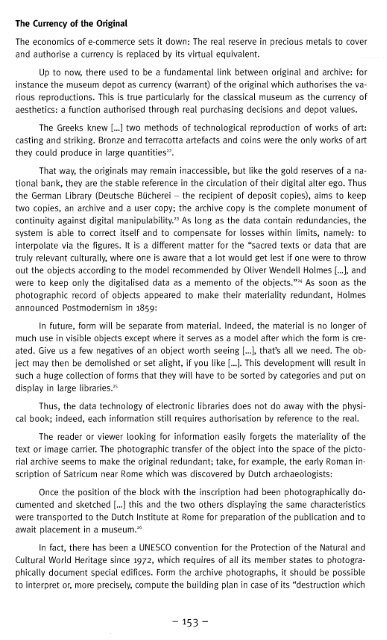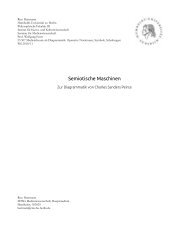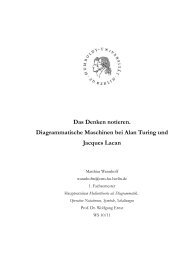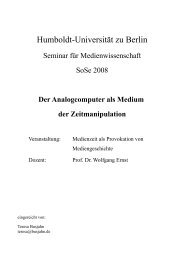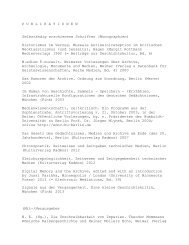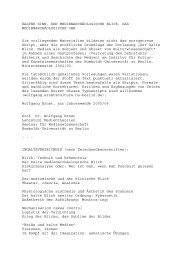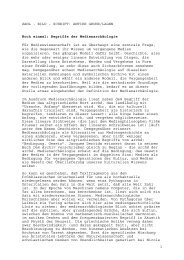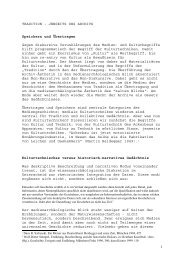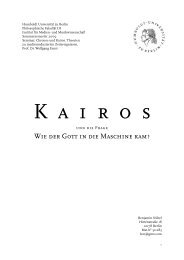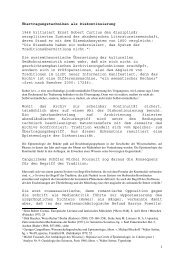Download - Medienwissenschaft
Download - Medienwissenschaft
Download - Medienwissenschaft
You also want an ePaper? Increase the reach of your titles
YUMPU automatically turns print PDFs into web optimized ePapers that Google loves.
The Currency of the Original<br />
The economics of e-commerce sets it down: The real reserve in precious metals to cover<br />
and authorise a currency is replaced by its virtual equivalent.<br />
Up to now, there used to be a fundamental link between original and archive: for<br />
instance the museum depot as currency (warrant) of the original which authorises the various<br />
reproductions. This is true particularly for the classical museum as the currency of<br />
aesthetics: a function authorised through real purchasing decisions and depot values.<br />
The Greeks knew [...] two methods of technological reproduction of works of art:<br />
casting and striking. Bronze and terracotta artefacts and coins were the only works of art<br />
they could produce in large quantities 22 .<br />
That way, the originals may remain inaccessible, but like the gold reserves of a national<br />
bank, they are the stable reference in the circulation of their digital alter ego. Thus<br />
the German Library (Deutsche Bücherei - the recipient of deposit copies), aims to keep<br />
two copies, an archive and a user copy; the archive copy is the complete monument of<br />
continuity against digital manipulability. 23 As long as the data contain redundancies, the<br />
system is able to correct itself and to compensate for losses within limits, namely: to<br />
interpolate via the figures. It is a different matter for the "sacred texts or data that are<br />
truly relevant culturally, where one is aware that a lot would get lest if one were to throw<br />
out the objects according to the model recommended by Oliver Wendell Holmes [...], and<br />
were to keep only the digitalised data as a memento of the objects." 24 As soon as the<br />
photographic record of objects appeared to make their materiality redundant, Holmes<br />
announced Postmodernism in 1859:<br />
In future, form will be separate from material. Indeed, the material is no longer of<br />
much use in visible objects except where it serves as a model after which the form is created.<br />
Give us a few negatives of an object worth seeing [...], that's all we need. The object<br />
may then be demolished or set alight, if you like [...]. This development will result in<br />
such a huge collection of forms that they will have to be sorted by categories and put on<br />
display in large libraries. 25<br />
Thus, the data technology of electronic libraries does not do away with the physical<br />
book; indeed, each information still requires authorisation by reference to the real.<br />
The reader or viewer looking for information easily forgets the materiality of the<br />
text or image carrier. The photographic transfer of the object into the space of the pictorial<br />
archive seems to make the original redundant; take, for example, the early Roman inscription<br />
of Satricum near Rome which was discovered by Dutch archaeologists:<br />
Once the position of the block with the inscription had been photographically documented<br />
and sketched [...] this and the two others displaying the same characteristics<br />
were transported to the Dutch Institute at Rome for preparation of the publication and to<br />
await placement in a museum. 26<br />
In fact, there has been a UNESCO convention for the Protection of the Natural and<br />
Cultural World Heritage since 1972, which requires of all its member states to photographically<br />
document special edifices. Form the archive photographs, it should be possible<br />
to interpret or, more precisely, compute the building plan in case of its "destruction which<br />
-153-


